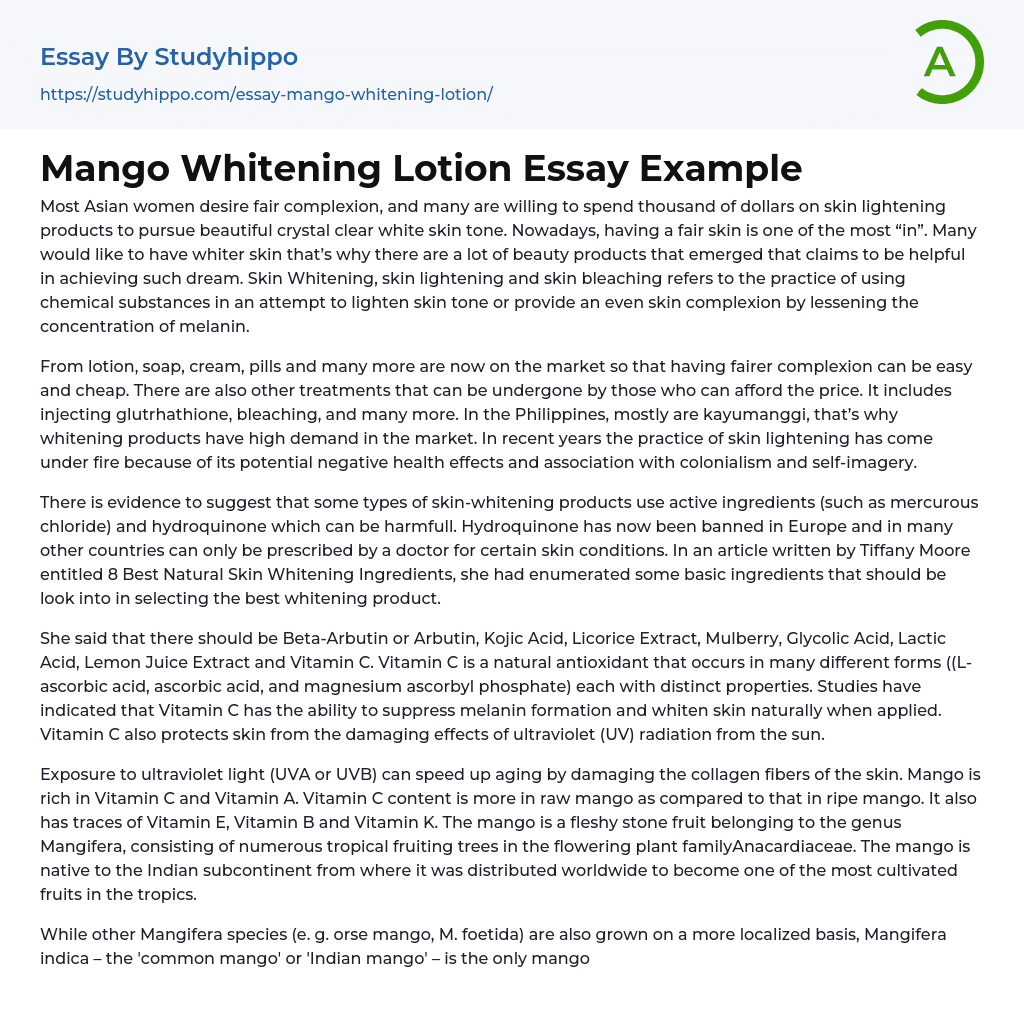There is a strong demand among Asian women to acquire fair skin, which is considered extremely desirable in modern society. In order to achieve this, many are willing to invest a substantial amount of money on skin lightening products. These beauty products claim to assist individuals in obtaining a flawless and radiant white complexion. Skin Whitening, skin lightening, and skin bleaching all employ the use of chemical substances to reduce melanin levels and lighten or even out the tone of the skin.
The market currently provides a range of skincare products, including lotion, soap, cream, pills, and more. These products make it more accessible and affordable to achieve lighter skin. Moreover, there are various treatments available for those who can afford them such as glutathione injections and bleaching. In the Philippines, where most individuals have a kayumanggi complexion, there is a significant demand for whitening products. However,
...the practice of skin lightening has recently been criticized due to its potential adverse health effects and its connection with colonialism and self-perception.
Tiffany Moore's article "8 Best Natural Skin Whitening Ingredients" highlights the dangers associated with certain skin-lightening products. These products have been found to contain hazardous substances such as mercurous chloride and hydroquinone. In fact, hydroquinone is prohibited in Europe and can only be acquired with a doctor's prescription in several other countries for specific skin conditions.
She recommended incorporating Beta-Arbutin or Arbutin, Kojic Acid, Licorice Extract, Mulberry, Glycolic Acid, Lactic Acid, Lemon Juice Extract, and Vitamin C in the formulation. Vitamin C is an antioxidant present in different forms (L-ascorbic acid, ascorbic acid, and magnesium ascorbyl phosphate), each with distinct characteristics. Studies have demonstrated that when applied t
the skin's surface, Vitamin C can hinder melanin production and promote natural improvement in skin luminosity. Moreover, it offers defense against harmful UV radiation emitted by the sun.
Exposure to ultraviolet light, whether UVA or UVB, can accelerate aging by damaging collagen fibers in the skin. Raw mangoes have a higher concentration of Vitamin C compared to ripe ones, making them an excellent source of both Vitamin C and Vitamin A. Mangoes also contain small amounts of other vitamins such as E, B, and K. They are juicy fruits with a firm inner core and belong to the Mangifera genus. These tropical fruits grow on different fruiting trees within the Anacardiaceae family. Originating from the Indian subcontinent, mangoes have gained global popularity and are extensively cultivated in tropical regions.
The most widely cultivated mango tree in tropical and subtropical regions is known as Mangifera indica, or the 'common mango' or 'Indian mango'. Other species, like M. foetida (horse mango), are grown in specific areas. The Indian mango holds the distinction of being the national fruit of India, Philippines, and Pakistan.
Hakeen Hashmi, a renowned Unani physician, has praised mangoes for their ability to fortify and vitalize nerve tissues in various parts of the body including muscles, heart, brain, and others. The pulp of the mango fruit contains antioxidant vitamins A and C, Vitamin B6 (pyridoxine), folate, various B vitamins, as well as essential nutrients such as potassium, copper, and amino acids.
Both the peel and pulp of a mango contain phytonutrients like carotenoids, polyphenols, and omega-3 and -6 fatty acids. The peel specifically has pigments such as beta-carotene, lutein, and alpha-carotene with antioxidant properties. These compounds can potentially
neutralize free radicals in disease processes based on initial studies. However, the quantity of these beneficial substances may vary depending on the specific mango variety.
Mango pulp contains a range of carotenoids, with beta-carotene being the most prevalent and responsible for giving mangoes their yellow-orange color. Mango also provides several health benefits. The leaves of mango trees produce mangiferin, which has various medicinal properties including anti-inflammatory, diuretic, chloretic, and cardiotonic activities. Moreover, mangiferin has potent antibacterial effects against gram positive bacteria and could potentially be used to prevent dental plaques.
Mango is a natural source of pro-vitamin A, which plays important roles in the development of both the placenta and fetus. Vitamin A also has critical functions in growth, skin and mucus membrane metabolism, dental health, and retina function. The nutritional value of mango makes it beneficial for various health conditions including weight gain, eye disorders, hair loss, heat stroke, prickly heat, diabetes, bacterial infections, sinusitis,
piles (hemorrhoids), indigestion, constipation,
morning sickness,
diarrhea,
dysentery,
scurvy,
spleen enlargement,
liver disorders,
menstrual disorders (leucorrhea),
and vaginitis.
Despite our limited understanding of the health benefits of mango, it remains a cherished fruit. Whether consumed in shakes, ice creams, pies, or other delightful mango-flavored treats, it is undeniably popular. This literature review has led researchers to explore the potential of utilizing mango as an ingredient in skin whitening lotions. With a focus on organic ingredients, mango emerges as a superior option compared to fruits like orange or any other alternatives.
- Microbiology essays
- Bacteria essays
- Cell essays
- Enzyme essays
- Photosynthesis essays
- Plant essays
- Natural Selection essays
- Protein essays
- Viruses essays
- Cell Membrane essays
- Human essays
- Stem Cell essays
- Breeding essays
- Biotechnology essays
- Cystic Fibrosis essays
- Tree essays
- Seed essays
- Coronavirus essays
- Zika Virus essays
- Food essays
- Genetically Modified Organisms essays
- Child Development essays
- Eating essays
- Breakfast essays
- Genetically Modified Food essays
- Milk essays
- Chewing gum essays
- Energy Drink essays
- Caffeine essays
- Chocolate essays
- vegetarian essays
- Weight Loss essays
- Anorexia essays
- Metabolism essays
- Diet essays
- Vitamin essays
- Dieting essays
- Junk Food essays
- Eating Habits essays
- Food Safety essays
- Food Security essays
- Beverages essays
- Cuisines essays
- Dairy essays
- Desserts essays
- Fast Food essays
- Bread essays
- Meal essays
- Meat essays
- Organic Food essays




